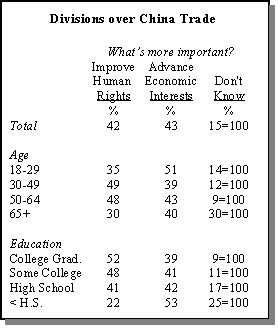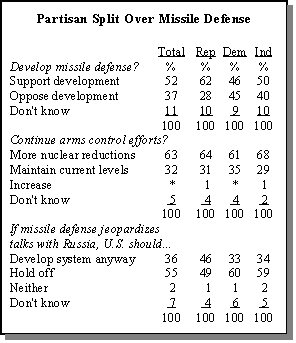Bush Bounces Back
 In the presidential race, key voting groups continue to shift back and forth between Bush and Gore, as the public is clearly having difficulty making up its mind about this contest. Some of the gains Gore made in the immediate aftermath of the primary season have since been reversed. Senior citizens rallied to Gore in March, preferring him over Bush by 62%-to-30%. Now this group divides much more evenly (49% Gore, 40% Bush). Similarly, those at the bottom of the income scale moved sharply away from Bush after the primaries, favoring Gore 64%-29%. Now that group prefers Gore by a narrower margin 50%-42% margin.
In the presidential race, key voting groups continue to shift back and forth between Bush and Gore, as the public is clearly having difficulty making up its mind about this contest. Some of the gains Gore made in the immediate aftermath of the primary season have since been reversed. Senior citizens rallied to Gore in March, preferring him over Bush by 62%-to-30%. Now this group divides much more evenly (49% Gore, 40% Bush). Similarly, those at the bottom of the income scale moved sharply away from Bush after the primaries, favoring Gore 64%-29%. Now that group prefers Gore by a narrower margin 50%-42% margin.
While Democrats and Republicans have remained steadfast in their support for their parties’ standard-bearers in recent months, independents have vacillated. In February, independents narrowly preferred Bush over Gore (45%-40%). At that time the two were in a statistical dead heat. In March, when Gore led Bush overall, independents swung to the vice president, choosing him over Bush 47%-39%. This month, independents’ have shifted their allegiances back to Bush and he narrowly leads Gore among this crucial swing group (46%-41%).
The poll identified several other important swing groups, who also preferred Gore in March but now opt for Bush. Among them are white women, older men, Southerners, and suburbanites.
With the general election less than six months away, it is clear that many of these important demographic groups are still up for grabs. It is impossible to predict what may move them, but if Bush were to pair up with John McCain (who has emphatically denied interest in the vice-presidential nomination), he would be in a much stronger position. In a hypothetical match-up pitting Bush and McCain against a Gore-Bradley ticket, the Republicans win by a ten-point margin (49%-39%). With McCain on board, women, senior citizens and those on the West Coast shift their allegiances. They prefer Gore in a head-to-head match-up, but opt for Bush when McCain is part of the package. The shift among seniors is especially striking: They choose Gore over Bush (49%-40%), but opt for Bush/McCain over Gore/Bradley 48%-37%.
Independents break narrowly for Bush under either scenario. However, Gore loses some Democrats with McCain on the GOP ticket: 79% of Democrats remain loyal to the vice president, vs. 90% of Republicans who would vote for Bush and McCain.
Bush Gains on Issues
 The poll suggests that Bush’s comeback is linked to support for his positions on issues. Fully 51% of Bush supporters say what they like most about the Texas governor is his stand on the issues, up from 42% in March. Roughly one-in-five (22%) say
The poll suggests that Bush’s comeback is linked to support for his positions on issues. Fully 51% of Bush supporters say what they like most about the Texas governor is his stand on the issues, up from 42% in March. Roughly one-in-five (22%) say
they like Bush’s leadership ability (virtually unchanged from March), 12% like his personality and 8% like his experience.
Bush’s personality is less of a liability now than was the case right after his bruising primary battle with McCain. In March, fully one-third of Bush opponents cited his personality when asked what they liked least about him. This month 25% point to this factor. Women are more likely than men to be turned off by Bush’s personality. Among Bush opponents, 29% of women vs. 20% of men say this is what they like least about the GOP candidate.
Gore’s strongest selling points remain his policy positions and experience. Four-in-ten Gore voters cite issues and another 30% cite experience when asked what they like most about the vice president. Young women are most in tune with Gore’s policy positions. More than half of women under age 50 (53%) value this factor above others, compared to only 30% of women age 50 and over. Gore’s male supporters are much more drawn to his experience than are his female supporters: 37% say this is what they like best about the vice president, vs. 24% of women.
Bush More Charismatic, Gore More Caring
Bush’s overall image remains stronger than Gore’s. Fully 58% of the public has a favorable opinion of Bush, while 31% view him unfavorably. These numbers are largely unchanged from March of 1999, when 61% of the public had a positive opinion. The public expresses a somewhat more divided view on Gore: 50% favorable vs. 38% unfavorable.
 Bush is more popular with Republicans (88%) than Gore is with Democrats (73%). And Gore has lost some ground over the last year among older Democrats. In March of last year, 82% of Democrats age 65 and older had a favorable view of the vice president. That number has fallen to 61% in the current survey. Half of independents give Gore a favorable rating compared to 59% who have a favorable opinion of Bush.
Bush is more popular with Republicans (88%) than Gore is with Democrats (73%). And Gore has lost some ground over the last year among older Democrats. In March of last year, 82% of Democrats age 65 and older had a favorable view of the vice president. That number has fallen to 61% in the current survey. Half of independents give Gore a favorable rating compared to 59% who have a favorable opinion of Bush.
Bush’s better image is tied to positive evaluations of him on a personal level. Bush out-polls Gore on a series of personal qualities. He’s seen as more charismatic, funnier and more interesting. Gore’s strongest point is his caring image. Overall Bush trumps Gore on five of the 11 qualities tested. Bush’s strongest points are on the most human of qualities. Voters choose him over Gore as the candidate with the most charisma (47%-31%) and the one with the better sense of humor (48% vs. 34%). He is also seen as having led an interesting life (43% vs. 31% for Gore). In addition, more voters see Bush as personally inspiring, though on this measure, many volunteered that neither candidate fits that description.
Gore has a clear edge in two categories: Compared to Bush, more voters view him as attractive (42% vs. 29%) and caring (44% vs. 34%). He is also seen as being slightly more mature and down to earth when compared to Bush. Neither candidate is seen as being more level-headed than the other.
When it comes to these personal qualities, men and women have starkly different perceptions of the candidates. Overall, men give Bush the edge over Gore on seven of the 11 qualities, while women choose Bush on only two. Men see Bush as level-headed, while women say Gore better meets that description. Men give Bush a clear edge on being more interesting, inspiring, telegenic, and honest. Women divide equally between Bush and Gore on each of these qualities. Men are much more likely than women to view Bush as the candidate with charisma (55% vs. 40%).
What Clinton Nostalgia?
 Despite talk that the public is longing for an extended Clinton era, the president’s favorability ratings have dropped significantly since last year. Less than half of the public (48%) now rates Clinton very or mostly favorable compared to 55% in March, 1999. These are among the lowest ratings the president has received since he took office in 1992.
Despite talk that the public is longing for an extended Clinton era, the president’s favorability ratings have dropped significantly since last year. Less than half of the public (48%) now rates Clinton very or mostly favorable compared to 55% in March, 1999. These are among the lowest ratings the president has received since he took office in 1992.
Clinton has lost some ground among most major demographic groups. Most notable, perhaps, is Clinton’s loss among core Democrats. One year ago, 85% of Democrats said their overall opinion of Clinton was very favorable or mostly favorable. Today, that number is 73%.
Young men and African-Americans view Clinton more favorably than members of other demographic groups. Almost six-in-ten men age 18-29 (59%) give Clinton a favorable rating, compared to only 46% of men over age 50. A strong majority of blacks (84%) also continue to view Clinton in a positive light.
Hillary’s Ratings also Slide
Hillary Clinton doesn’t fare any better than her husband in the public’s view. The first lady’s favorability ratings have slipped dramatically across nearly all demographic groups since the impeachment crisis in December 1998. At that time, nearly two-thirds (66%) of the public had a favorable opinion of Hillary Clinton. Since then, her ratings have dropped 17 percentage points to 49%, virtually the same as her husband’s current ratings. Her ratings were lower, however, in early 1996, when she was under the shadow of the Whitewater investigations. (See questionnaire.)
With the first lady locked in a tough race for the Senate against New York Mayor Rudy Guiliani, there are deeper partisan divisions over her public image. Only one-quarter (24%) of Republicans now have a favorable opinion of Hillary Clinton, compared to 44% in December 1998. The drop is particularly apparent among Republican women. Two-and-a-half years ago, slightly more than half (51%) of GOP women looked favorably on her. Today, that number stands at one-quarter.
Giuliani, Clinton’s opponent, remains unknown to about half of the American public. Among those who can identify the New York mayor, 67% have a favorable opinion of him. Not surprisingly, Republicans are among Giuliani’s strongest supporters, 81% view him favorably. Yet even among Democrats, Guiliani still gets a 59% favorability rating.
McCain Still Popular
 Sen. McCain gets positive favorability ratings from 73% of those able to rate him. McCain’s popularity cuts across party lines: Republicans (75%), Democrats (70%) and independents (74%) all have a favorable view of McCain. But his numbers were even higher in December 1999, when a CNN/USA Today poll found 84% looking on McCain favorably.
Sen. McCain gets positive favorability ratings from 73% of those able to rate him. McCain’s popularity cuts across party lines: Republicans (75%), Democrats (70%) and independents (74%) all have a favorable view of McCain. But his numbers were even higher in December 1999, when a CNN/USA Today poll found 84% looking on McCain favorably.
The candidates’ wives still remain unknown to many people. More can identify Gore’s wife, Tipper than Bush’s wife, Laura. However, among those who can rate, Laura Bush gets a slightly higher favorability rating (77%) than Tipper Gore (73%). Women hold equally high opinions of Tipper Gore and Laura Bush, 81% and 78%, while men favor Bush by a margin of 77% to 64%.
In the wake of the Elian Gonzalez affair, Attorney General Janet Reno is in a virtual tie with Hillary Clinton for last among the public figures tested. Slightly more than half (55%) have a favorable opinion of the first female attorney general. That is a decline from 66% who had a favorable opinion of her in a December 1998 Gallup poll.
Americans continue to rate Secretary of State Madeleine Albright favorably. Among the public who could identify Albright, nearly three quarters (72%) have a favorable opinion of her. This is down from 82% in April 1997, but not a significant change from the 74% who gave her a positive rating in March 1999.
Gates, Greenspan Liked
Despite the recent court ruling against Microsoft, Bill Gates’ ratings are higher now than before the anti-trust verdict against his company. Among those who can rate him, Gates gets the highest favorability ratings out of the newsmakers tested in this survey. Fully eight-in-ten Americans who knew of Gates rated him favorably.
Federal Reserve Board Chairman Alan Greenspan also remains popular, in spite of the continuing turmoil in the stock market. More than three-quarters (76%) of those able to rate Greenspan give him a favorable rating. The wealthiest and best-educated Americans give Greenspan the most positive ratings: 87% of those making more than $75,000 and 88% of those with at least a college degree say they have a favorable opinion of the Fed chairman.
Jobs Top Priority in China Trade
 With Congress about to vote on granting China permanent trade benefits, the public remains equivocal on this issue. But clearly, the factor driving opinion is its expected impact on the job situation in the United States. Attitudes on whether or not the deal will boost commerce with China or advance democracy there are less important than opinions on whether jobs will be created, or lost, in this country.
With Congress about to vote on granting China permanent trade benefits, the public remains equivocal on this issue. But clearly, the factor driving opinion is its expected impact on the job situation in the United States. Attitudes on whether or not the deal will boost commerce with China or advance democracy there are less important than opinions on whether jobs will be created, or lost, in this country.
Overall, the public remains wary of granting China permanent normal trade relations; only 30% favor that step, against 49% who are opposed. The gap has narrowed slightly since February, when 28% supported granting China permanent trade benefits and 56% were opposed. Yet when people are informed of details of the U.S.-China agreement — that Beijing has agreed to lower trade barriers to enter the World Trade Organization and gain permanent normal trade relations from the U.S. — a plurality comes down in favor of the deal (39% believe it would be good for the country, against 21% who disagree and 25% who say it would make no difference). Support for the deal has grown slightly since February, when 34% said it would be beneficial for the United States, 20% disagreed, and 32% said it would make no difference.
While many people (50%) have not yet heard of the trade agreement, there is widespread concern that it will result in a loss of jobs from the United States. A majority (52%) believes jobs will be lost, against only 24% who say jobs will be created. Feelings about jobs, more than human rights or future sales to China, influence Americans’ attitudes toward the question of permanent trade relations with China, and the agreement generally.
On the question of whether the trade deal will be good or bad for the United States, there is a 51 percentage point gap between those who believe China’s entry into the World Trade Organization will create jobs in the United States (74%) versus those who say it will cost jobs (23%). The differences are sizable, but not as large, between those who believe the WTO agreement will lead to more or less U.S. sales to China (36 points), and those who say trade does or does not foster democracy in China (also 36 points).
In general, Americans are skeptical that trade will lead to greater democracy in China. Just one-third (32%) believe trade will foster democracy, while 47% disagree. And Americans are evenly split over just how strongly the United States should emphasize human rights in its trade relationship with China, with 43% saying advancing economic interests should take priority, while 42% believe human rights are most important.
 But when the 42% who favor human rights are pressed on the tradeoff between rights in China and jobs at home, by better than a two-to-one margin they say that improving human rights is not worth losing U.S. jobs. On the other hand, more than half of the 43% who cite economic interests believe the United States should make some effort at advancing human rights, while roughly one-third believe human rights should not be a concern.
But when the 42% who favor human rights are pressed on the tradeoff between rights in China and jobs at home, by better than a two-to-one margin they say that improving human rights is not worth losing U.S. jobs. On the other hand, more than half of the 43% who cite economic interests believe the United States should make some effort at advancing human rights, while roughly one-third believe human rights should not be a concern.
A strong majority (60%) of those who support permanent trade benefits, believes that economic interests should take precedence over improving China’s human rights. Opponents of permanent normal trade status for China, by a 50%-43% margin, say human rights should take priority. Members of union households, by a 52%-39% margin, advocate placing U.S. economic interests over human rights.
Men place economic interests over human rights in China (by 48%-40%), while women believe human rights is a more important consideration (by 44%-38%). Americans over age 65 and those under 30 believe economic interests should take priority; middle-aged Americans (age 30-64) come down on the side of human rights.
Split Verdict on Missile Defense
Americans are supportive of plans to develop a national missile defense system, but they don’t want that program to undercut negotiations aimed at reducing nuclear stockpiles in the United States and Russia. Overall, a slim majority (52%) favors development of a ground- and space-based missile defense system, against 37% who oppose building such a system.
Support for missile defense is greater than it was in 1987, when former President Ronald Reagan championed the “Star Wars” system to defend the United States from a nuclear attack. In May of that year, the public, when asked a slightly different form of the question, was evenly split with 44% in favor and 42% opposed.
 But Americans also strongly endorse ongoing efforts to reduce the size of U.S. and Russian nuclear arsenals. More than six-in-ten (63%) back those negotiations, against 32% who believe no further reductions are necessary. Consequently, a strong majority (55%) says the United States should hold off developing a missile defense system and focus on negotiating deeper arms reductions with the Russians. Slightly more than one-third (36%) believe the United States should press ahead with a missile defense program even if that jeopardizes bilateral arms control efforts.
But Americans also strongly endorse ongoing efforts to reduce the size of U.S. and Russian nuclear arsenals. More than six-in-ten (63%) back those negotiations, against 32% who believe no further reductions are necessary. Consequently, a strong majority (55%) says the United States should hold off developing a missile defense system and focus on negotiating deeper arms reductions with the Russians. Slightly more than one-third (36%) believe the United States should press ahead with a missile defense program even if that jeopardizes bilateral arms control efforts.
Perhaps not surprising, given Reagan’s strong advocacy of “Star Wars,” Republicans are much more supportive of missile defense than Democrats. Fully six-in-ten (62%) Republicans favor that program, with just 28% opposed. Democrats are fairly evenly split, as 46% support development of a system and 45% are opposed.
But when asked about the possibility that building the system could jeopardize nuclear reduction efforts, support among members of both parties falls considerably. Republicans are split on this question, with 46% backing deployment and 49% who want to hold off; just 33% of Democrats favor going ahead under those circumstances and 60% are opposed.
Independents favor developing a missile defense system (by a margin of 50%-40%), but like Democrats, they strongly oppose going ahead if that step jeopardizes progress in arms control talks with Russia. Indeed nearly six-in-ten (59%) favor delaying development under those circumstances, about the same percentage of Democrats supporting that position.
The public is paying relatively little attention to this issue. Just 10% say they have heard a lot about the debate, while another 43% say they have heard a little. The gender gap is evident here as well: More than half of men (54%) who have heard something about the debate favor going ahead with the system, even if that imperils arms talks with Russia. Most women (61%) support the opposite approach, saying the United States should delay development.


